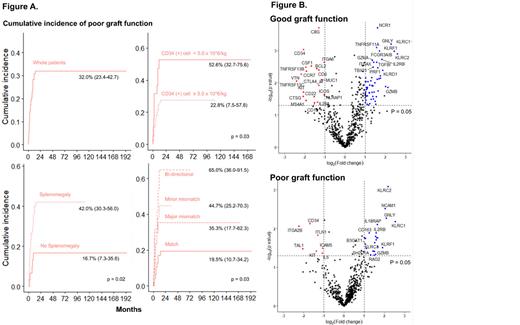Allogeneic hematopoietic stem cell transplantation (HSCT) is widely recognized as the sole curative treatment for myelofibrosis (MF). However, patients with MF often experience graft function impairment despite successful engraftment and absence of relapse signs. Although it has been reported that poor graft function can have a negative impact on the outcomes of patients with MF after HSCT, the specific factors that can influence poor graft function are not yet clearly understood. In this background, we analyzed various clinical and immunological factors that may contribute to poor graft function after transplantation.
The study included 93 patients who underwent HSCT for the treatment of MF at Seoul St. Mary's Hospital between the years 2000 and 2022. By cumulative incidence analysis of poor graft function (death, relapse, graft failure, and loss of chimerism as competing risks), we evaluated which pre-HSCT factors has significant impact on poor graft function after HSCT. The definition of poor graft function and graft failure in this study followed the criteria set by the European Society for Blood and Marrow Transplantation (EBMT). We measured the longitudinal diameter of spleen up to 2 months prior to HSCT, and classified the patients into pre-HSCT splenomegaly (≥ 14cm) or not. Next, we investigated the association of immune-related gene expression signature in bone marrow immune-microenvironment with the occurrence of poor graft function, by performing targeted gene expression profiling and gene set enrichment analysis using a custom NanoString panel composed of 579 immune-related genes in pre- and post-HSCT BM samples from patients with poor graft function and good graft function (total 24 samples).
A median age of 93 patients was 57 years, and 55.9% were male. Secondary MF was observed in 30.1% of the cases. Fifty-three (57.0%) received graft from a matched sibling donor graft and 40 (43.0%) from a matched unrelated donor. Sixty-three (67.7%) patients were classified to the pre-HSCT splenomegaly group. In terms of ABO match, 45 (48.4%) patients were matched, 10 (10.8%) had bi-directional mismatch, 17 (18.3%) had major mismatch, and 19 (20.4%) had minor mismatch. The median infused CD34 (+) cell dose was 6.4 x 10^6/kg (Interquartile range 5.3 x 10^6/kg-8.3 x 10^6/kg).
In our patients, cumulative incidence of poor graft function after 5 years from HSCT was 32.0% (95% CI: 23.4-42.7). Infused CD34 (+) cell dose, the presence of splenomegaly before HSCT were revealed to have an impact on the occurrence of poor graft function after HSCT. The other significant factor associated with poor graft function was ABO mismatch, in particular, with a substantial difference between matched patients and patients with bi-directional ABO mismatch. (Figure A). In NanoString panel analysis, although the expression of immune-related genes mostly upregulated after HSCT, genes related to processes such as complement system, inflammasomes, phagocytosis and degradation, and MHC class II antigen presentation pathways were significantly downregulated in PGF. Whereas, oxidative stress, inflammasomes, and autophagy pathways were downregulated in GGF (Figure B).
In this study, we could observe that a significant proportion of MF patients undergoing HSCT experienced poor graft function. Factors that significantly associated with the occurrence of poor graft function included the CD34 (+) cell dose at the time of HSCT, the presence of splenomegaly before HSCT, and ABO mismatch. Interestingly, distinct gene expression signatures present in IME between pre- and post-SCT in both PGF and GGF. Further research is warranted to investigate the impact of poor graft function caused by these factors on outcomes such as transfusion requirements and quality of life.
Disclosures
Lee:Alexion, AstraZeneca Rare Disease: Honoraria, Membership on an entity's Board of Directors or advisory committees, Research Funding; Achillion: Research Funding; AlloVir: Consultancy; Arrowhead: Consultancy; Kira: Consultancy; Samsung: Consultancy.


This feature is available to Subscribers Only
Sign In or Create an Account Close Modal